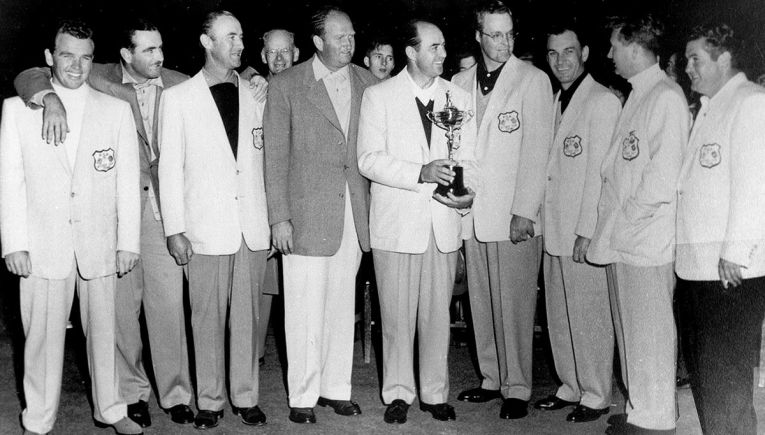
The victorious American Ryder Cup team in 1951 at Pinehurst.
BY ALEX PODLOGAR
PHOTOS COURTESY OF THE TUFTS ARCHIVES
LOOK CLOSELY AT THE BLACK-AND-WHITE PHOTOS in the hall of the Pinehurst Resort Clubhouse. The ones aged by time and history. The winning United States team at the 1951 Ryder Cup played on Pinehurst No. 2 stands together, smiles wide on their faces and nattily attired in light suits befitting the American South culture.
Captained by Sam Snead and led by Ben Hogan, the U.S. team had little trouble with their counterparts from Britain. The Americans won handily 9 ½-2 1/2, as The Wardrobe, Jimmy Demaret, capped perhaps the greatest Ryder Cup career in the game’s long history.
Wedged between Snead and Hogan is Skip Alexander, a rising star on the fledgling PGA Tour and a former All-American from nearby Duke University. At 6-foot-2, 200 pounds, Alexander can’t be missed, his hair slicked back in the fashion of the day, his glasses crystal clear.
Hidden, though, are Alexander’s hands.
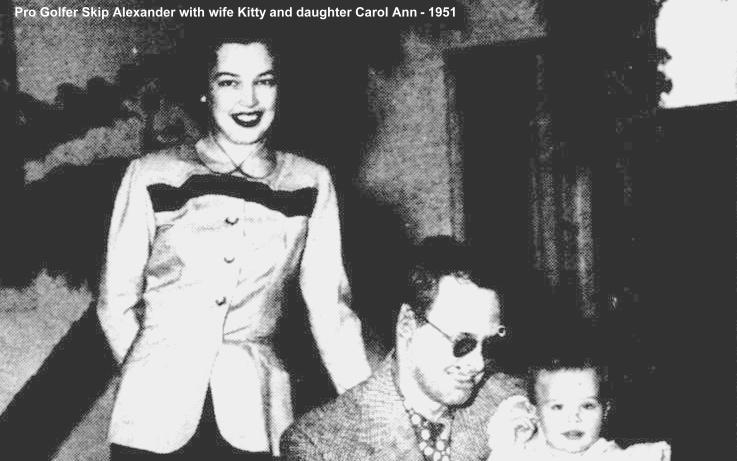
SKIP ALEXANDER HAD BEEN TO PINEHURST before. He won the prestigious North and South Amateur in 1941 in the midst of a collegiate career that led to his enshrinement in the Duke Hall of Fame. He won twice on the PGA Tour in 1948, finishing fifth on the money list with $18,000 in earnings. Alexander had no trouble making the 1949 Ryder Cup team.
None of it was easy, though. Especially with a young family in tow.
“In ’49 I restructured my life and it was kind of tough traveling,” Alexander told members of the St. Petersburg Country Club many years later. “We traveled with the baby in ’50. We had a suitcase that made into a bed, so we did all right. But it was a whole new life. We had several long hops (by car), for instance, from Tucson to San Antonio, Texas. That was one of the big ones. And from Houston to Philadelphia, that was another one. The tour didn’t have much money at that time. I hate to say this, but I was fifth-leading money winner one year and made $18,000 or a little more. And the leading-money winner made $27,000 or $32,000. So we had to make the cut and finish in the top 10 to even stay out on the tour. We (tour players) were just a group of vagabonds traveling together. We were a close-knit group (of 75-85 players) cuttin’ up the same pie every week.”
Nearly through the 1950 season, Alexander continued to keep pace with the game’s greats. Snead. Hogan. Byron Nelson. Cary Middlecoff. All winners on Pinehurst No. 2 somewhere along the line. Alexander was in elite company, and after finishing sixth at the Kansas City Open in late September, he was eighth on the money list.
Alexander, though, was ready for a break. An exhibition trip to South America was looming. But he needed to see his young family, which had stayed home this time, in North Carolina. The Civil Air Patrol, with three officers ready to take off from Kansas City to Louisville, offered Alexander a lift. The date was Sept. 24, 1950.
It was the kind of break only a star would get.
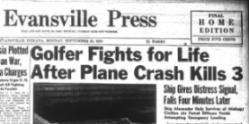
NEARING EVANSVILLE, INDIANA, the small plane’s reserve fuel tank malfunctioned. This was fatal. The plane was going down.
“Since we were near the Evansville airport, we banked in to land and almost made it, crashing on the edge of the field,” Alexander told the St. Petersburg Evening Independent’s John Steen on Jan. 16, 1951. “The next thing I remember was trying to force my way out of the cabin door and meeting a wall of flames. I quickly shut the door and opened it again, running out of the wreck on my broken left ankle. I guess I got about 50 yards before I collapsed and the fuel tank exploded.”
His flesh melting from the fire, Alexander raced those 50 yards in about 20 seconds before the plane disintegrated.
He was the only one who made it out of the plane, the three CAP officers killed. But he wasn’t out of the woods yet.
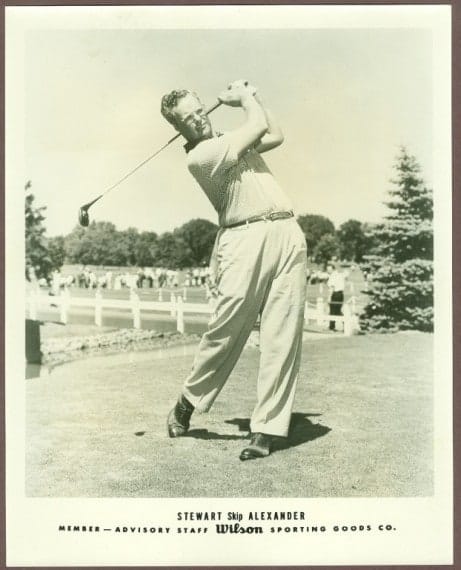
ALEXANDER SPENT THE NEXT FIVE MONTHS in hospitals before finally being released from Duke University Hospital on Feb. 28, 1951. In all, he would endure 17 surgeries as a result of the crash.
On the day he was released, Alexander accepted the head golf professional position at Lakewood Country Club in Florida, his residence. His career thought over, Wilson Sporting Goods renewed his sponsorship contract as a Christmas gift. Nelson, Middlecoff, Clay Heafner and Orville Wright organized a golf match to benefit the Carolinas’ PGA Skip Alexander $10,000 Fund.
But to Alexander, he wasn’t done. His 726 points toward the ’51 Ryder Cup team had a chance to hold up.
“Only his deep blue eyes were the same when he emerged,” wrote The St. Petersburg Times Sports Editor Bill Beck. “They appeared in usual quizzical, friendly fashion from a scar-tissue face that would have put a lesser man on a psychiatrist’s couch. His hands were twisted so that his fingers stuck out at odd angles like the scarecrow’s in the Wizard of Oz. But he served notice on the golfing world that he would take up the tournament trail again after a Winter’s rest.”
But to play, Alexander needed those fingers fixed. The doctors complied.
“My hands were all burned and (now) they’re all skin-grafted,” Alexander recalled to the country club. “The extensors and (other) parts of the fingers were contracted so (tightly) that I didn’t have any openings. The doctors opened them up. They took a knuckle out and fused the (remaining) two knuckles together so they would fit a golf club.”
Months of rehabilitation still awaited him. But Alexander pressed on. He wanted to play again.
“I was a little fire running away from a big fire,” Alexander told Beck of the crash.
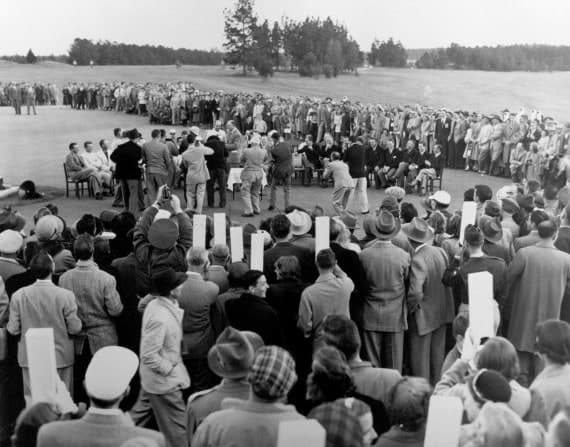
THE NINTH PLAYING OF THE RYDER CUP 65 YEARS AGO was vastly different than the intense worldwide multimedia event it is today. In early November of 1951, only 30 correspondents, including just three from London and three from Scotland, descended on Pinehurst. There were estimates of a mere 6,000 spectators for Sunday’s singles matches, and even as the Cup was being contested, visiting golfers continued to play on Pinehurst courses No. 1 and 3, and on nine holes of No. 4.
It was high season for Pinehurst, and Pinehurst owner Richard Tufts found himself in the unenviable position of being forced to turn away nearly 600 potential guests. But Pinehurst No. 2, which had been closed for three months in preparation for hosting the Ryder Cup, was ready for the game’s greatest, according to famed British golf correspondent Henry Longhurst.
“With the grass about three inches thick on the fairways and the ground untrodden for three months, at 7,007 yards on the card and playing more like 9,000, it was murder — brassies, brassies all the way, as the poet might have said — and it was not long before my partner and I agreed upon it as an admirable battlefield for the Sneads and Mangrums of this world but no fit stomping ground for aging investment brokers and golf correspondents.”
Fourteen months removed from a horrifying plane crash, and just eight months since finally being released from the hospital, it was unclear whether Alexander was ready for such a world class competition. He had played a smattering of tournaments leading up to the Ryder Cup to secure his position on the team, but Alexander was one of two players on the 10-man U.S. squad held out of play during Friday’s team matches.
On Saturday, the teams took a break in play, with many of them instead traveling to Chapel Hill to watch a football game between Tennessee and North Carolina.
“They said, ‘In North Carolina when Carolina plays Tennessee in a football game on Saturday, nobody watches golf,’” Alexander recalled decades later. “So they took the day off and we all went to the football game.”
Tennessee won 27-0, but the Tar Heels weren’t the only casualty.
“It was cold and (Dutch) Harrison got sick and Snead came to me and said, ‘Can you play?’” Alexander said. “I told him, ‘Yes, I can play.’”
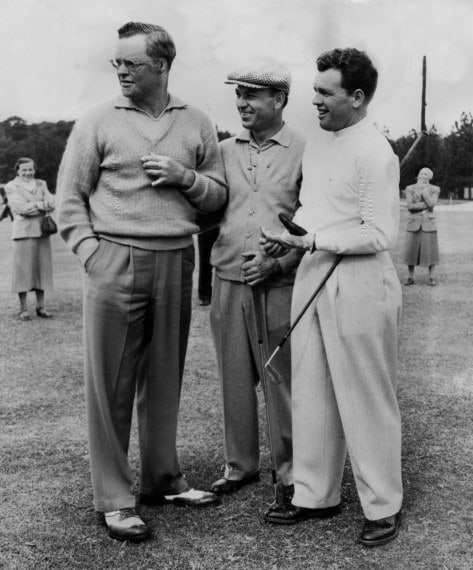
Skip Alexander, at left, stands with Ben Hogan (center) and Jackie Burke during the 1951 Ryder Cup at Pinehurst.
THE AMERICANS ENTERED SUNDAY’S singles matches with a 3-1 lead following Friday’s play. Still, the Cup would be decided with the 36-hole singles matches, and Snead had to tread carefully. He still needed 3 ½ points for the U.S. to retain the Cup, and the Americans had not lost it since 1933.
Perhaps protecting Alexander or maybe to get into his opponent’s head, Snead paired Alexander against Britain’s top player, John Panton, who had topped the Order of Merit and won the Vardon Trophy. Panton, a member of three Ryder Cup teams, would finish his career with 38 professional victories. Years later, like the “Arnold Palmer,” Panton had a beverage named after him. The mix of non-alcoholic ginger beer and a dash of lime cordial was named the “John Panton.”
All things considered, Alexander didn’t see the logic in the matchup.
“I don’t know whether Snead knew that I was going to play … and (Sam) was just forfeiting the match or leading the lambs to the slaughter,” Alexander told the St. Petersburg Country Club. “But having to play their No. 1 man, I wouldn’t have been the choice. I’d have had Hogan play him.”
Alexander didn’t know whether he could even finish 36 holes. He had never played a 36-hole match before.
It turned out he didn’t have to.
His hands bleeding throughout the match, Alexander pulled off one of the most unlikely upsets in the playing of the Ryder Cup. Beating Panton 8 & 7, Alexander helped the Americans clinch the Cup with the most lopsided match in the event’s history to that point.
Even Alexander couldn’t believe it.
“I was all bandaged up; my hands were bleeding,” he told the country club. “I played John Panton, the Vardon Trophy winner, Order of Merit winner, leading money winner and everything. I’d never walked 36 holes before that, and it was a 36-hole match. So I took off, and every time I played a hole, I wondered if I could play the next. But it worked out all right (chuckling). I beat him 8 & 7, which as I heard, was the biggest margin that anybody had won by. … I three-putted No. 10 though, in that afternoon round, or I might have won 9 & 8. I remember wondering if that was the beginning of the end and I wouldn’t win another hole.”
He was right. Alexander never won again.
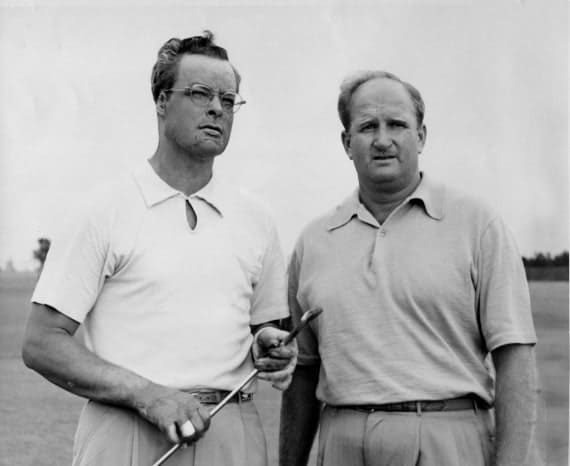
Skip Alexander (left) with Clayton Heafner.
LAUDED THROUGH MUCH OF THE NEXT YEAR, Alexander was honored in January by Philadelphia sportswriters as the “Most Courageous Athlete” of 1951.
The Associated Press covered the event:
“His face lined with scars and his fingers, which once controlled some of golf’s best shotmaking, still bent and bruised, Alexander told some 1,300 diners that he owed part of his recovery to letters and telegrams of encouragement from people all over the nation. ‘It was sort of borrowed courage,’ he said.”
Alexander went on.
“It was undoubtedly my sporting instinct, that natural effort to win against all odds, that helped carry me through my recent trying days,” he told the audience. “My faith in the doctors and the unflinching encouragement of my wife, plus the thought of our 2-year-old daughter, carried me past many discouraging moments.”
Still he expected more in golf. Alexander envisioned a return to the Tour, but soon found he could no longer compete regularly at the highest level.
“I played in a couple of Masters, but didn’t have any success playing on the Tour after the accident,” he said.
Alexander never left golf. He settled in at Lakewood, now known as the St. Petersburg Country Club, where he served as the head golf professional for 34 years — the job he was given as he rose from his Duke University Hospital bed for the last time. In addition to the Duke Hall of Fame, Alexander has been enshrined in the North Carolina Hall of Fame and the Carolinas Golf Hall of Fame. Alexander’s son Buddy won the U.S. Amateur in 1986 and eventually became the head golf coach at the University of Florida, leading the Gators to two national championships.
Skip Alexander passed away in 1997, leaving behind a legacy in golf – and the Ryder Cup – few can match.
Associated Press columnist Oscar Fraley couldn’t have been more prescient on March 4, 1952, when he wrote, “Skip smiles under that new ear and eye lid and refuses to consider anything but an ever-brightening future.”
In a frame on the wall of Pinehurst’s historic clubhouse, the smile never fades.

